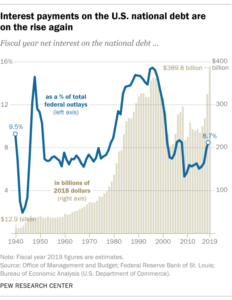The out-of-control level of spending taking place to battle COVID-19 is much scarier when it’s coupled with the near shutdown of our economy.
Shutting down the economy because of a pandemic is unprecedented in contemporary America. The much more deadly Spanish flu didn’t stop World War I. In fact, more people died from the Spanish flu than died in the Great War.
The Centers for Disease Control estimated that H1N1, the 2009 pandemic, infected 60.8 million worldwide. No country shut down its economy. We’ve dealt with Ebola, avian flu, AIDS and other medical horrors without shuttering American businesses.
Shutting down the economy, New York Governor Andrew Cuomo said and many would agree, was all worth it if we save one life.
But COVID-19 isn’t the only thing that can kill you. Because of our shutdown, millions are losing their jobs – at a time when it will be difficult to find a new job. Job loss could be the tipping point between living comfortably and living without a home.
The shutdown will boost not only homelessness, but addiction to drugs and alcohol. It will lead to depression. It is already creating stress, which will result in even more illness. It is destroying businesses that entrepreneurs dedicated their lives to building.
While we should do everything possible to stop the spread of COVID-19, as Dr. Joseph A. Ladapo wrote in The Wall Street Journal, “On the other side is everything else that matters: livelihoods that allow people to feed and shelter their families; civil liberties; the education of children; social well-being, including the prevention of loneliness, isolation and domestic violence; and all other medical conditions, from cancer and heart disease to dental emergencies.”
Before the pandemic, the unemployment rate was the lowest it’s been in 50 years. Since the pandemic began, more than 20 million Americans have lost their jobs. And many business closures will not be temporary. Many retailers barely survived the financial crisis and the trend toward online shopping; now they face another crisis that will prove fatal to many businesses.
The shutdown comes at a time when, in spite of relatively strong economic growth in recent years, debt levels are at historic highs and interest rates are at historic lows. There is no leeway to take on more debt or lower rates.
American Progress noted that, “the U.S. nonfinancial corporate debt of large companies is currently around $10 trillion, up from around $4.8 trillion in 2003. Deutsche Bank released analysis showing the world’s major economies harboring the highest debt levels of the past 150 years, with World War II as an exception.
“They all still need to continue repaying that debt, even if jobs, customers, and tax revenues decline in a weakening economy. These fixed costs then will leave less money to spend on other things. Large amounts of debt often exacerbate an economic slowdown, especially if central banks can do little to ease that burden by cutting interest rates.”
And what will our legislators do about taxes? Tax revenues will be far lower this year, because businesses have been idled. That will mean that far less money will be coming in to pay for far more spending.
Rather than address these issues, Congress will likely just add to the federal debt, which will dramatically increase the cost of servicing our debt.
Servicing the Debt
In 2019, the cost of servicing the federal debt was $479 billion. This year, the cost will be much higher, even with interest rates near zero. And not a penny of that money will be available to feed and house the poor, build roads, protect our country or create more resources to prevent future pandemics.
In addition, as The Wall Street Journal noted, “the overhang of debt from the current shutdown will prevent central banks from raising rates to combat consumer price rises, meaning inflation running in the mid-to-high single digits.”
And yet, many in Washington are pushing for even more spending. Much more.
Ironically, though, trying to stimulate the economy with demand-side policies during a forced shutdown is bound to fail.
As economist and fund manager Daniel Lacalle wrote, “There is no demand to ‘incentivize’ when the government orders the closing of all activities. And there is no supply to follow when the economic crisis creates a collapse in employment and consumption.”
Even if businesses were to reopen tomorrow, it would take many years for them to recover. When you’re driving and you come to a complete stop, it takes a time to pick up speed again.
“Each month of lockdown means more than millions of unemployed,” Lacalle wrote. “It means thousands of businesses that go bankrupt and have to close forever.”
Cautiously allowing some businesses to operate and gradually return to normal, may result in more cases of COVID-19, but it would enable us to get through the crisis faster. The longer the economy remains closed down, the greater the long-term impact will be on our quality of life, our mental health and our financial well-being.
According to Lacalle, “A pandemic crisis is addressed by providing safety protocols and sanitary equipment for businesses to continue to run and keep employment, not shutting down everything, which may create a larger social and health problem in the long term regardless of the massive liquidity and fiscal policies.”
There are no good choices here. But keeping the economy shut down is clearly a bad choice.
